The Cotton Bags Market is estimated to be valued at USD 2.3 billion in 2025 and is projected to reach USD 4.0 billion by 2035, registering a compound annual growth rate (CAGR) of 5.8% over the forecast period.
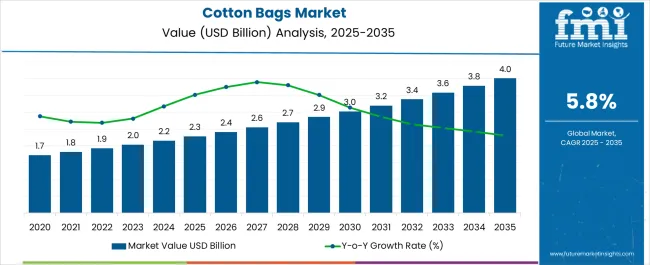
| Metric | Value |
|---|---|
| Cotton Bags Market Estimated Value in (2025 E) | USD 2.3 billion |
| Cotton Bags Market Forecast Value in (2035 F) | USD 4.0 billion |
| Forecast CAGR (2025 to 2035) | 5.8% |
The Cotton Bags market is experiencing significant growth due to increasing global awareness of sustainable and eco-friendly alternatives to plastic. Growing environmental regulations and government initiatives to reduce plastic waste are driving adoption across various regions. Consumers and businesses are increasingly shifting toward reusable and biodegradable packaging solutions, which has created strong demand for cotton-based bags.
The market is further supported by rising awareness of health and safety concerns associated with synthetic materials. Technological advancements in cotton processing and bag manufacturing have improved durability and design versatility, enhancing the attractiveness of cotton bags for commercial and personal use. Additionally, expansion in retail, food, and industrial sectors has bolstered market demand, creating opportunities for innovative designs and functional features.
The market is expected to continue growing as consumer preference for eco-conscious products rises, and supply chains adapt to meet the increasing volume requirements efficiently Integration of branding and customization options in cotton bags has also contributed to higher adoption rates, providing both marketing and sustainability benefits.
The cotton bags market is segmented by capacity, end use, type, and geographic regions. By capacity, cotton bags market is divided into Up To 5 Kg, 5Kg – 10 Kg, 10 Kg – 15 Kg, 15 Kg – 20 Kg, and Above 20 Kg. In terms of end use, cotton bags market is classified into Automotive, Chemical, Agriculture, Oil And Gas, Research And Development, and Others. Based on type, cotton bags market is segmented into Calico (Unbleached Or Unprocessed Cotton) Bags, Beach Cotton Bags, and Tote Cotton Bags. Regionally, the cotton bags industry is classified into North America, Latin America, Western Europe, Eastern Europe, Balkan & Baltic Countries, Russia & Belarus, Central Asia, East Asia, South Asia & Pacific, and the Middle East & Africa.
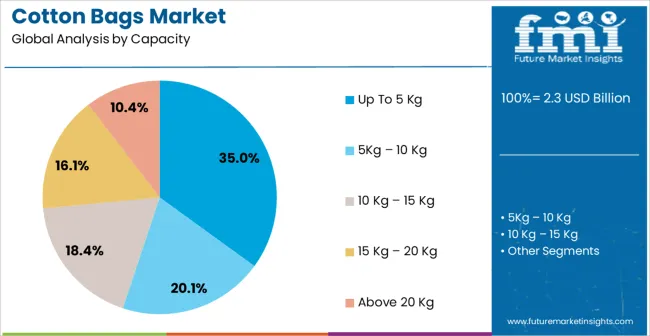
The Up To 5 Kg capacity segment is projected to hold 35.0% of the Cotton Bags market revenue share in 2025, making it the leading capacity category. This segment has been favored due to its suitability for everyday use, ease of handling, and compatibility with retail and grocery applications. The lightweight nature allows convenient transport for consumers while maintaining sufficient strength for repeated use.
The growth of this segment has been reinforced by increasing consumer preference for practical and environmentally responsible alternatives to plastic shopping bags. Retailers have actively promoted these bags through loyalty programs and brand initiatives, driving broader acceptance.
Additionally, the production efficiency and lower material costs associated with smaller capacity bags have enhanced profitability for manufacturers, supporting widespread distribution As consumer awareness of sustainable products continues to expand, the Up To 5 Kg capacity segment is expected to maintain its leading position, supported by ongoing innovation in design and manufacturing processes.
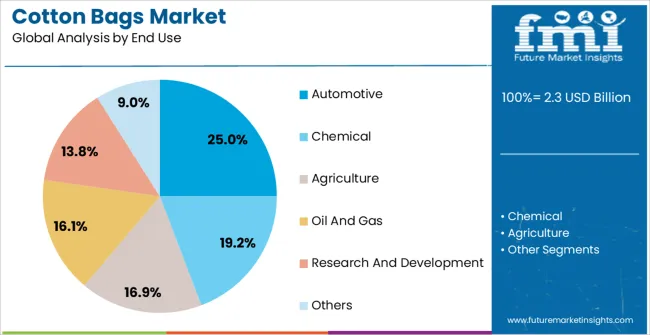
The Automotive end-use segment is estimated to account for 25.0% of the Cotton Bags market revenue share in 2025, emerging as the dominant sector. This segment’s growth has been driven by demand for durable and reusable bags for corporate giveaways, trade shows, and employee kits. Cotton bags are preferred in this sector due to their robustness, customizable design potential, and alignment with sustainability initiatives undertaken by automotive companies.
The ability to incorporate branding and promotional messaging further enhances their utility in marketing campaigns. The rise of eco-conscious corporate policies and increased focus on environmental responsibility has further strengthened the adoption of cotton bags in the automotive sector.
Manufacturers benefit from scalable production and standardized sizing that meets commercial requirements, reducing logistics complexity Continued growth in the automotive industry and emphasis on environmentally responsible practices are expected to reinforce the leading position of this end-use segment in the market.
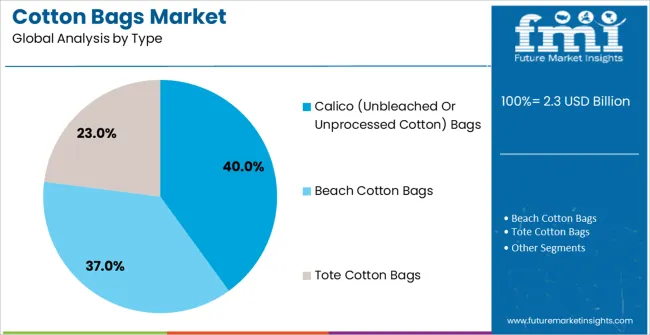
Calico (Unbleached Or Unprocessed Cotton) Bags are projected to hold 40.0% of the Cotton Bags market revenue share in 2025, making them the leading type segment. The popularity of calico bags is being driven by their natural appearance, biodegradability, and versatility for printing and customization. Consumers and businesses alike favor these bags for retail, promotional, and everyday use due to their eco-friendly profile and cost-effectiveness.
Production of calico bags requires minimal chemical processing, which aligns with the rising preference for sustainable and chemical-free products. Their durability and reusability further enhance market appeal, providing a practical alternative to single-use bags.
Additionally, manufacturers have leveraged calico’s adaptability in design, allowing for a range of sizes and printing options that support marketing campaigns and brand visibility As environmental regulations tighten and consumer preference for sustainable products grows, calico cotton bags are expected to continue dominating the market, reinforcing their position as the preferred type segment.
The ecofriendly cotton bags are anticipated to overtake plastic bags in the retail sector during the forecast period. Increasing availability of decorated cotton bags is inciting people to increasingly adopt cotton bags. Cotton bags have high printability & shelf appeal as compared to plastic bags.
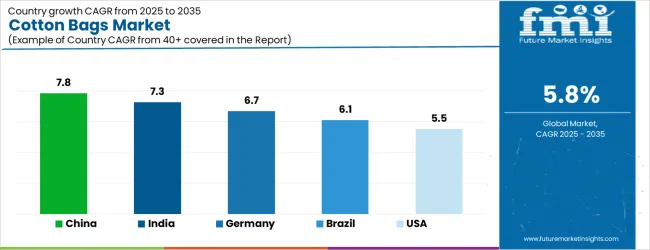
| Country | CAGR |
|---|---|
| China | 7.8% |
| India | 7.3% |
| Germany | 6.7% |
| Brazil | 6.1% |
| USA | 5.5% |
| UK | 4.9% |
| Japan | 4.4% |
The Cotton Bags Market is expected to register a CAGR of 5.8% during the forecast period, exhibiting varied country level momentum. China leads with the highest CAGR of 7.8%, followed by India at 7.3%. Developed markets such as Germany, France, and the UK continue to expand steadily, while the USA is likely to grow at consistent rates. Japan posts the lowest CAGR at 4.4%, yet still underscores a broadly positive trajectory for the global Cotton Bags Market. In 2024, Germany held a dominant revenue in the Western Europe market and is expected to grow with a CAGR of 6.7%. The USA Cotton Bags Market is estimated to be valued at USD 838.4 million in 2025 and is anticipated to reach a valuation of USD 838.4 million by 2035. Sales are projected to rise at a CAGR of 0.0% over the forecast period between 2025 and 2035. While Japan and South Korea markets are estimated to be valued at USD 122.6 million and USD 57.1 million respectively in 2025.
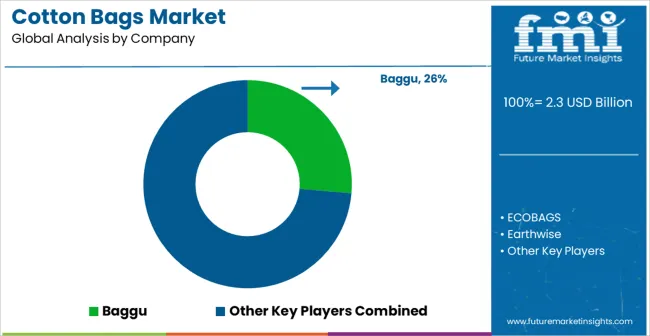
| Item | Value |
|---|---|
| Quantitative Units | USD 2.3 Billion |
| Capacity | Up To 5 Kg, 5Kg – 10 Kg, 10 Kg – 15 Kg, 15 Kg – 20 Kg, and Above 20 Kg |
| End Use | Automotive, Chemical, Agriculture, Oil And Gas, Research And Development, and Others |
| Type | Calico (Unbleached Or Unprocessed Cotton) Bags, Beach Cotton Bags, and Tote Cotton Bags |
| Regions Covered | North America, Europe, Asia-Pacific, Latin America, Middle East & Africa |
| Country Covered | United States, Canada, Germany, France, United Kingdom, China, Japan, India, Brazil, South Africa |
| Key Companies Profiled | Baggu, ECOBAGS, Earthwise, ChicoBag, The Cotton Bag Company, Unionwear, Enviro-Tote, and ToteBagFactory |
The global cotton bags market is estimated to be valued at USD 2.3 billion in 2025.
The market size for the cotton bags market is projected to reach USD 4.0 billion by 2035.
The cotton bags market is expected to grow at a 5.8% CAGR between 2025 and 2035.
The key product types in cotton bags market are up to 5 kg, 5kg – 10 kg, 10 kg – 15 kg, 15 kg – 20 kg and above 20 kg.
In terms of end use, automotive segment to command 25.0% share in the cotton bags market in 2025.






Our Research Products

The "Full Research Suite" delivers actionable market intel, deep dives on markets or technologies, so clients act faster, cut risk, and unlock growth.

The Leaderboard benchmarks and ranks top vendors, classifying them as Established Leaders, Leading Challengers, or Disruptors & Challengers.

Locates where complements amplify value and substitutes erode it, forecasting net impact by horizon

We deliver granular, decision-grade intel: market sizing, 5-year forecasts, pricing, adoption, usage, revenue, and operational KPIs—plus competitor tracking, regulation, and value chains—across 60 countries broadly.

Spot the shifts before they hit your P&L. We track inflection points, adoption curves, pricing moves, and ecosystem plays to show where demand is heading, why it is changing, and what to do next across high-growth markets and disruptive tech

Real-time reads of user behavior. We track shifting priorities, perceptions of today’s and next-gen services, and provider experience, then pace how fast tech moves from trial to adoption, blending buyer, consumer, and channel inputs with social signals (#WhySwitch, #UX).

Partner with our analyst team to build a custom report designed around your business priorities. From analysing market trends to assessing competitors or crafting bespoke datasets, we tailor insights to your needs.
Supplier Intelligence
Discovery & Profiling
Capacity & Footprint
Performance & Risk
Compliance & Governance
Commercial Readiness
Who Supplies Whom
Scorecards & Shortlists
Playbooks & Docs
Category Intelligence
Definition & Scope
Demand & Use Cases
Cost Drivers
Market Structure
Supply Chain Map
Trade & Policy
Operating Norms
Deliverables
Buyer Intelligence
Account Basics
Spend & Scope
Procurement Model
Vendor Requirements
Terms & Policies
Entry Strategy
Pain Points & Triggers
Outputs
Pricing Analysis
Benchmarks
Trends
Should-Cost
Indexation
Landed Cost
Commercial Terms
Deliverables
Brand Analysis
Positioning & Value Prop
Share & Presence
Customer Evidence
Go-to-Market
Digital & Reputation
Compliance & Trust
KPIs & Gaps
Outputs
Full Research Suite comprises of:
Market outlook & trends analysis
Interviews & case studies
Strategic recommendations
Vendor profiles & capabilities analysis
5-year forecasts
8 regions and 60+ country-level data splits
Market segment data splits
12 months of continuous data updates
DELIVERED AS:
PDF EXCEL ONLINE
Cotton Candy Maker Market Forecast and Outlook 2025 to 2035
Cotton Processing Equipment Market Size and Share Forecast Outlook 2025 to 2035
Cottonseed Meal Market Analysis by Product Type, Nature and End Use Industry Through 2025 to 2035
Cottonseed Oil Market Analysis – Size, Share & Forecast 2025-2035
Cotton Candy Machines Market - Fluffy & Sweet Treats 2025 to 2035
Cottonseed Hulls Market Analysis by Form, End Use, and Region through 2025 to 2035
Examining Market Share Trends in the Cotton Candy Maker Industry
Polybags Market Size and Share Forecast Outlook 2025 to 2035
Net Bags Market
VCI Bags Market
Sandbags Market
Leno Bags Market Size and Share Forecast Outlook 2025 to 2035
Silo bags Market Size and Share Forecast Outlook 2025 to 2035
Poly Cotton Market Growth - Trends & Forecast 2025 to 2035
Food Bags Market Share, Size, and Trend Analysis for 2025 to 2035
Poly Cotton Fabric Market Growth - Trends & Forecast 2025 to 2035
Competitive Breakdown of Silo Bag Manufacturers
Paper Bags Market Size and Share Forecast Outlook 2025 to 2035
Jumbo Bags Market Size and Share Forecast Outlook 2025 to 2035
Blood Bags Market Size and Share Forecast Outlook 2025 to 2035

Thank you!
You will receive an email from our Business Development Manager. Please be sure to check your SPAM/JUNK folder too.
Chat With
MaRIA